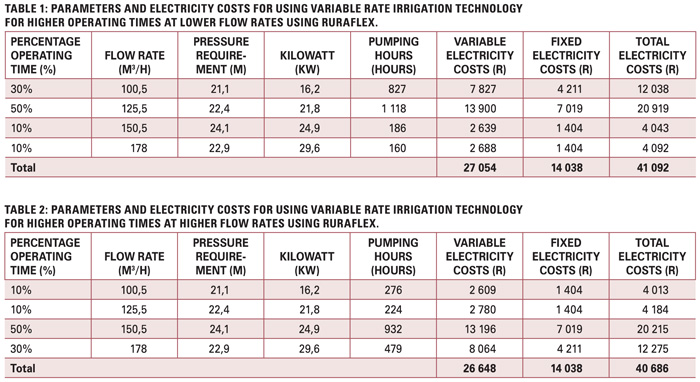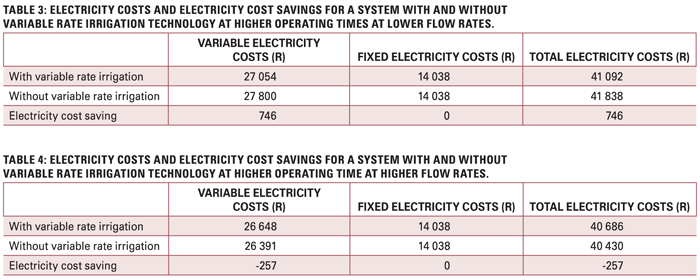October 2017
Ever increasing production costs are a serious threat to the sustainability of irrigation producers. Over the past 15 years, production costs of wheat and maize under irrigation increased significantly. The major contributors towards the increase in production costs are fertiliser, seed and irrigation costs.
Increases in irrigation costs are due to ever increasing electricity costs. The recent increases in electricity tariffs have created serious problems for irrigation producers. Thus, irrigation producers will need to evaluate different options to manage electricity and water costs in the future.
Significant opportunities exist for irrigation producers to reduce electricity costs through irrigation system design, renewable energy resources and operating practices to improve profitability.
Renewable energy resources (wind energy, hydroelectricity and solar panels) require a large amount of capital and are not always affordable to irrigation producers with a cash flow constraint. The design of an irrigation system and the operating practices need to be evaluated in order to reduce electricity costs.
Potential electricity savings can be achieved by adopting new technologies such as variable speed drives, high efficiency motors and variable rate irrigation. Variable rate irrigation allows the irrigator to apply different volumes of water to each section of the field which maximise yields and profitability (Lindsay, undated).
Variable rate irrigation has a few potential benefits for the irrigator, which include the following (Lindsay, undated):
However, despite all the potential benefits, it is important to compare the investment costs of variable rate irrigation with the potential electricity cost savings, thus, taking cognisance of the trade-off between investment costs and electricity costs.
When variable rate irrigation is applied to an irrigation system the flow rate and pressure requirement of the system change, since different volumes of water are applied to each section of the field. The change in flow rate and pressure requirement change the kilowatt usage and irrigation hours of the system, which change the electricity costs and can lead to electricity cost savings.
The saving in electricity cost is the maximum investment cost of variable rate irrigation technology since that represent the economic benefit an irrigator will receive from investing in variable rate irrigation.
The savings in electricity costs or maximum investment costs were calculated by comparing an irrigation system without variable rate irrigation technology with an irrigation system which has variable rate irrigation technology. The Soil Water Irrigation Planning – Energy (SWIP – E) (Venter, 2015) model was used to calculate electricity costs by using four different flow rates and pressure requirements for a system with variable rate irrigation.
The same model was applied to calculate electricity cost for a system without variable rate irrigation.
Application
The cost calculation model was applied to calculate the electricity cost saving (minimum investment cost of variable rate irrigation) for variable rate irrigation technology for a 30,1 ha centre pivot with four different flow rates and pressure requirements using the Ruraflex (time-of-use) electricity tariff.
An assumption was made about the percentage flow rate and pressure requirement that the centre pivot operates at for each section of the field. Table 1 and Table 2 illustrate the flow rate, pressure requirement, kilowatt usage, pumping hours, variable, fixed and total electricity costs for two different combinations of the percentage operating time at each section of the field.


Table 3 and Table 4 illustrate the electricity costs for a system with and without variable rate irrigation technology for two different combinations of operating times at each section of the field, respectively.
A system with higher operating times at lower flow rates resulted in electricity cost saving of R746 for the 30,1 ha centre pivot (Table 3). The electricity cost saving is not significant for variable rate irrigation technology since the maximum investment cost of variable rate irrigation technology is lower than the actual investment cost of variable rate irrigation technology (Lee, undated), however, variable rate irrigation technology has other significant benefits.
The system with the higher operating time at higher flow rates did not result in any electricity cost savings (Table 4). Thus, investing in higher flow rates is more economically beneficial than variable rate irrigation technology. Higher flow rates apply more water, which lead to lower irrigation hours and thus lower electricity costs.
However, higher flow rates have higher kilowatt usage, but the decrease in irrigation hours is more significant than the increase in kilowatt usage which results in lower electricity costs. Thus, the interaction between irrigation hours and kilowatt usage has a significant effect on electricity costs and the maximum investment costs of variable rate irrigation technology.
Different factors will influence the economic benefit of variable rate irrigation which include the design of the system, the operating times at each section of the field, different soil types, management and electricity tariffs.
Variable rate irrigation has a lot of benefits for the irrigator, but it is important that each system is analysed individually to determine the economic benefit of variable rate irrigation technology.
Future research
In the future further research will be done to calculate the economic benefit of variable rate irrigation for different irrigation systems as well as to include other factors that influence the economic benefit of variable rate irrigation in the cost calculation model.
For more information, contact Marcill Venter at VenterM5@ufs.ac.za or 051 401 3450.
Publication: October 2017
Section: Focus on